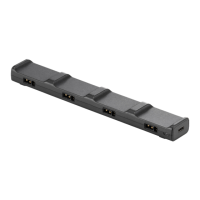21
© 2022 DJI All Rights Reserved.
Aircraft
DJI Avata contains a flight controller, gimbal and camera, video downlink system, vision system, propulsion
system, and an Intelligent Flight Battery.
Flight Modes
DJI Avata has three ight modes, which can be switched via the ight mode switch or button on the remote
control devices.
Normal Mode: The aircraft utilizes GNSS, the Downward Vision System, and the Infrared Sensing System to
locate itself and stabilize. When the GNSS signal is strong, the aircraft uses GNSS to locate itself and stabilize.
When the lighting and other environmental conditions are sucient, the aircraft uses the vision system. When the
Downward Vision System is enabled and lighting conditions are sucient, the maximum ight attitude angle is 25°
and the maximum ight speed is 8 m/s.
Sport Mode: The aircraft utilizes the GNSS and Downward Vision System to automatically stabilize itself. In
Sport mode, aircraft responses are optimized for agility and speed making it more responsive to control stick
movements. The maximum ight speed is 14 m/s.
Manual Mode: Classic FPV aircraft control mode with the highest maneuverability, which can be used for racing
and freestyle ying. In Manual mode, all ight assistance functions such as automatic stabilization are disabled and
procient control skills are required.
In Normal or Sport mode, when the Downward Vision System is unavailable or disabled and when the GNSS
signal is weak or the compass experiences interference, the aircraft cannot position itself or brake automatically,
which increases the risk of potential ight hazards. At this time, the aircraft may be more easily aected by its
surroundings. Environmental factors such as wind can result in horizontal shifting, which may present hazards,
especially when ying in conned spaces.
Manual mode is only supported when using the DJI FPV remote controller 2 to operate the aircraft, and
the throttle stick can be adjusted in this mode. DJI motion controller does not support Manual mode.
When using Manual mode, move the remote control sticks to directly control the throttle
and attitude of the aircraft. The aircraft has no flight assistance functions such as automatic
stabilization and can reach any attitude. Only experienced pilots should use Manual mode. Failure
to operate in this mode properly is a safety risk and may even lead to the aircraft crashing.
Manual mode is disabled by default. Make sure that the switch is set to Manual mode in the goggles
before switching to Manual mode. The aircraft will remain in Normal or Sport mode if the switch
is not set to Manual mode in the goggles. Go to Settings > Control > Remote Controller > Button
Customization, and then set the Custom Mode to Manual Mode.
Before using Manual mode, it is recommended to adjust the screw on the rear of the throttle stick so
that the stick does not recenter and to practice ying in the mode using DJI Virtual Flight.
When using Manual mode for the rst time, the maximum attitude of the aircraft will be limited. After
you are familiar with ying in Manual mode, the attitude restriction can be disabled in the goggles. Go
to Settings > Control > Remote Controller > Gain & Expo > M Mode Attitude Limit.
When turning the aircraft at high speed in Manual mode avoid moving the aircraft laterally to ensure a
stable ight.
The maximum speed and braking distance of the aircraft significantly increase in Sport mode. A
minimum braking distance of 30 m is required in windless conditions.
The responsiveness of the aircraft signicantly increases in Sport mode, which means a small control
stick movement on the remote controller translates into the aircraft moving a large distance. Make sure
to maintain adequate maneuvering space during ight.

